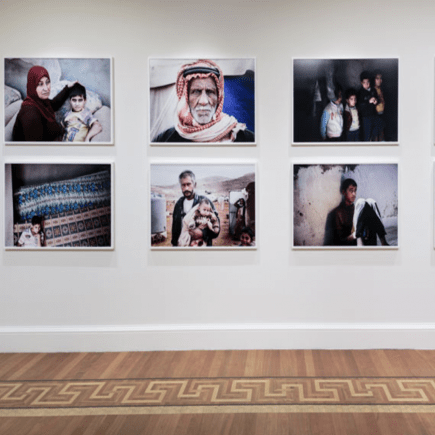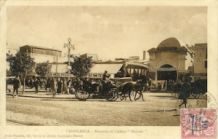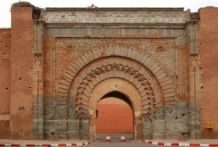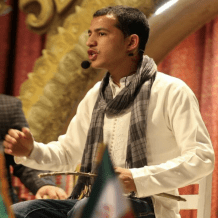
Photographer’s Leila Alaoui: Rites of Passage A Virtual Tour
Due to England’s second Covid lockdown, a new, virtual tour and exhibition launched Leila Alaoui: Rite of Passage at the Somerset House. Guided by award-winning broadcaster and cultural commentator Ekow Eshun the showing will attract a broad-based community who are fans of Alaoui and those interested in Moroccan photography. Somerset House is situated at the very heart of London and home to the UK’s largest creative community, overflowing with new ideas and young businesses. It is ideal for nurturing creativity and empowering artists. The exhibition opened to coincide with 1-54 Contemporary African Art Fair in October 2021.
Born in Paris and raised in Marrakech, the New York, educated Leila Alaoui worked as a commercial photographer for magazines and NGOs and completed assignments on refugees. Her photos have been published in numerous publications, including The New York Times and Vogue. She also completed assignments for the Spanish TV reality show El Mago.
Alaoui’ focus was to capture the in-depth tradition that may get lost and the unseen stories. Also, to offer an intimate portrait into the rich cultural identities and resilience of societies facing uncertain realities. Her picked subjected are pictured across the contemporary Mediterranean-landscape and beyond from Syrian refugees fleeing civil war in Lebanon to young North Africans looking desperately into an alternative bright future in Europe.
On her deep interest in exploring this complex theme, Alaoui once reflected: “Throughout my adolescence in Morocco, stories of migrants drowning at sea became regular on the news. In my eyes, these stories were constant reminders of deep-rooted social injustice. My French-Moroccan identity gave me the privilege of crossing borders freely while others couldn’t.”
“She was trying to present these individuals from a pictorial point of view,” explained José Tono Martínez of the Spanish cultural management firm, Hélicon Axis, to Arab News. “She wanted to also present them with a lot of respect, like the portraits made by the great painters during the 15th and 16th centuries. She was not fond of the (Orientalist) point of view. If you see her pictures, you will see this sort of objective presentation, with a lot of dignity. These are not executives working in Rabat or Casablanca. She was interested in portraying a Morocco that was disappearing and she was conscious of that.”
Alaoui had previously shared the objective behind the series, and echoed Martinez’s insights: “Its images are an attempt to bear witness to the rich cultural and ethnic diversity of Morocco, an archival work on the aesthetics of disappearing traditions through contemporary digital photography.”
“She represents something very positive, which is what we need to demonstrate in front of non-Arabs in Europe,” said Nuria Medina García, the cultural programs coordinator at Casa Árabe. “She was cultivated and had a commitment to her society and intellectual tradition, embodying many positive values. For us, as an institution, it’s very important to give visibility to people like Leila, who really contradicts the many negative images that are coming from Arab countries at the current moment.”
Leila Alaoui traveled many small Moroccan towns and rural areas where she set up a mobile studio and invited ordinary people to have their photograph taken. Showing great sensitivity towards her subjects, Alaoui’s images are both informed yet artistic, giving a human face to the people who often become lost and misrepresented behind waves of news coverage and statistics.
In 2016, whilst working on a women’s rights campaign with Amnesty International, Alaoui was caught in gunfire during a terrorist attack in Ouagadougou, Burkina Faso, and three days later died of her wounds at the age of 33 but her photography lives on and her storytelling lives on.
The exhibition of Leila Alaoui is a set of three rooms, the first one is Les Marocains (2014), which celebrated the cosmopolitan fabric of life in contemporary Morocco. Ekow Eshun said: “one of the striking elements of the Moroccan of the series, is that the photographs are printed pretty much at a life size. So that you are looking directly into the eyes of these individuals. Looking around the room you are immersed in an idea of people and place, of Morocco. Seen through the eyes of Moroccan people”.
Second is a set of two: No Pasara (2008), which documented the voyages of North African migrants to Europe. “Photos of people suspended in this state or place between trying to get somewhere, and trying to leave somewhere”. “That this isn’t about capturing the singular reality of individuals, this is really about talking about sensibility, this is really about talking about mood and tone, loss and longing and all the really complicated experiences, that take people beyond their home to the edge of a potential new life. All the frustration involved in that; all the hopes involved in that” by Ekow.
And Natreen (We Wait) (2013), which focused on families who had fled the Syrian civil war. “So many times, we see people looking into the camera with a real intensity of gaze and I think that the success of this as a project is to do with the connection, the empathic connection that Leila Alaoui makes between herself, her subject and us, as a viewer of that.” By Ekow.
The third and final room includes an unfinished video project L’Ile du Diable (Devil’s Island), on which she was working at the time of her death, featuring dispossessed migrant workers at the old Renault factory in Paris.
“Across the course of the film we hear the voices of different French politicians, at different times welcoming immigrants, and other time castigating and blaming immigrants for a corruption French society.” By Ekow.
Alaoui’s photography is an invitation to see and connect with the world, and the people she encountered, through her eyes. Alaoui was strongly committed to getting to know the communities and people she met, resulting in her sincere and authentic bodies of work.
Ekow Eshun’s tour through Rite of Passage encourages viewers to consider those who so often become lost and misrepresented behind waves of news coverage and statistics. Encountering Alaoui’s life-size portraits from their own homes, viewers come face-to-face with the people she met, creating a powerful sense of intimacy.
With thanks to The Leila Alaoui Foundation, created to preserve her work, defend her values, and inspire and support artistic engagement.
Leila Alaoui: Rite of Passage is the ninth exhibition in The Charles Russell Speechlys Terrace Rooms Series, an ongoing partnership with the leading law firm to present a wide range of free exhibitions reflecting the broad interests of both organizations.
For those who missed it in its opening weeks, the virtual tour offers the opportunity to still discover Alaoui’s timely and moving work, and gain insight into the evolution of her practice, before she was killed.
Audiences can also enjoy an online talk between Eshun and acclaimed photographer Hassan Hajaj, as they reflect on Rite of Passage and the great sensitivity Alaoui applied to her practice. Leila Alaoui: Rite of Passage will reopen in Somerset House’s Terrace Rooms as soon as government guidance permits.





